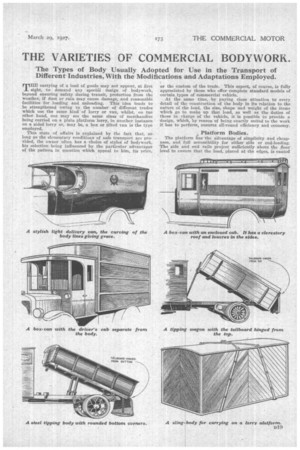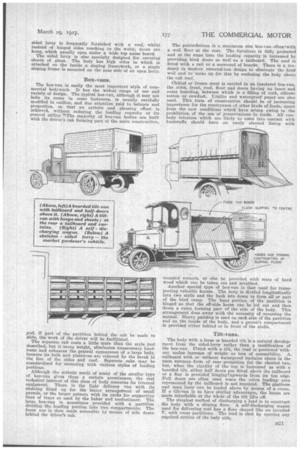THE VARIETIES OF COMMERCIAL BODYWORK.
Page 89

Page 90

Page 91

If you've noticed an error in this article please click here to report it so we can fix it.
The Types of Body Usually Adopted for Use in the Transport of Different Industries, With the Modifications and Adaptations Employed.
THE carrying of a load of goods may not appear, at first sight, to demand any speciAl design of bodywork, beyond ensuring safety during transit, protection from the weather, if dust or rain may cause damage, and reasonable facilities for loading and unloading. This idea tends to be strengthened owing to the number of different trades which use the same kind of lorry or van, whilst, on tne other hand, one may see the same class of merchandise being carried on a plain platform lorry, in another instance on a sided lorry or, may be, a box or tilted van is the type employed.
This state of affairs is explained by the fact that, so long as the elementary conditions of safe transport are provided, the owner often has a choice of styles of bodywork, his selection being influenced by the particular advantages of the pattern in question which appeal to him, its price,
or the custom of the trade. This aspect, of course, is fully appreciated by those who offer complete standard models of certain types of commercial vehicle.
At the same time, by paying close attention to every detail of the construction of the body in its relation to the nature of the load, the size, shape and weight of the items which go to make up that load, as well as the duties of those in charge of the vehicle, it is possible to provide a design, which, by reason of being exactly suited to the work it has to perform, ensures all-round efficiency and economy.
Platform Bodies.
The platform gas•the advantage 'of simplicity and cheapness, and full accessibility for either side or end-loading. The side and end rails project sufficiently above the floor level to ensure that the load, placed at the edges, is canted inwards. If the goods are to be slid on and off, then a dwarf tailboard is provided. The absence of sides allows bulky packages which are wider than the body to be carried. Modification of the platform consists of providing various heights of front and haek boards, so that the load may be piled against them, a ridge pole to support a waterproof sheet, or stanchions and chains to form a aide guard for barreLs Or churns. When the platform is quite plain, binding cleats and hooks are necessary for roping the load securely.
The platform is also used as a double-decker, which is found highly convenient for house-to-house delivery by the greengrocer and mineral-water manufacturer, or with a half upper deck for increasing the floor area when carrying churns. For heavy work, a low floor is an improvement which often necessitates the construction of wheel arches. The obstruction so caused is reduced to a minimum by giving the arches a flat top.
The platform is used for carrying the sling-van--that is, a box body which can be lifted and transported independently from one vehicle to another. The container is, in effect, a small sling-van.
Sided Lorries.
When sides, front and tailboard are added, the body is better adapted for carrying a much wider range of goods. When the load consists of sealed containers, such as tins D20
of petrol or barrels of beer, the sides and end need only consist of a framework, thereby saving weight and material, although the amount of labour entailed is often greater than that for solid construction. Openwork or skeleton sides provide ventilation; therefore, they are necessary for a livestock lorry. The tailboard is often solid, even when the sides are slatted, because it forms, in many instances, a temporary extensioli. of the floor.
A favourite method of fixing plank sides is by means of angle irons which are bolted to inside plates and turned at the foot and bolted to the cross bearers. If a more distinctive • style he required, then the sides have a wooden framework and are boarded usually on the inside only. A special variety of sided lorry is that used by the market gardener, with its sides and ends extended upwards by means Of .ladders or loading racks.
The builder and timber merchant require a -gantry mounted behind the cab so as to provide a bearing for ladders, poles and lengths of timber. An adjustable middle gantry is often used, as well :18 a bar to take the weight off the open tailboard. An important modification of the sided lorry is the provision of hinged sides. These I militate loading, but weaken the structure. To compensate for this fixed stanchions in the middle and rear are sometimes used.
• For brewers' use, particularly, the plank or skeleton sided lorry is frequently furnished with a roof, whilst instead of hinged sides reaching to the waist, doors are hung, which usually open under a wide top name board.
The sided lorry is also specially designed for carrying sheets of glass. The body has high sides to which is attached on the inside a sloping framework, or a single sloping frame is mounted on the near side of an open lorry.
Box-vans.
The box-van is easily the most important style of commercial bodywork. It has the widest range of use and variety of design. The typical box-van, although it may not belie its name in some instances, is usually carefully modified in outline, and due attention paid to balance and proportion, so that an artistic and pleasing effect is achieved, without reducing the loading capacity or its general utility.The majority of box-van bodies are built with the driver's cab forming part of the main construction, and, if part of the partition behind the cab he made to 'slide, the work of the driver will be facilitated.
The separate cab costs a little more than the style just described, but it saves weight, eliminates unnecessary headroom and enhances the general appearance of a large body, because its bulk and plainness are relieved by the break in the line of the sides and roof. Separate cabs may be standardized for mounting with various styles of loading portions.
Although the artistic merit of many of the smaller type of box-van gives them a certain prominence, the real technical interest of this class of body concerns its internal equipment. There is the light delivery van with its shelving fitted up for the better arrangement of small parcels, or the larger pattern with its racks for supporting tiers of trays as used by the baker and confectioner. The large box-van is sometimes provided with a partition dividing the loading portion into two compartments. The front one is then made accessible by means of side doors behind the driver's cab. The pantechnicon is a maximum size box-van.often‘with a well floor at the rear. The furniture is fully protected and at the same time the loading capacity is increased by providing hind doors as well as a tailboard. The roof is fitted with a rail or a surrouud of boards. There is a tendency in modern removal-van design to eliminate the hind well and to' make up for this by enclosing the body above the cab roof.
Chilled or frozen meat is carried in an insulated box-van, the sides, front, roof, floor and doors having an inner and outer boarding, between which is a filling of cork, silicate cotton or sawdust. Uralite and waterproof paper are also used. This form of construction should be of increasing importance for the conveyance of other kinds of foods, apart from the new conditions which 'have arisen owing to the prohibition of the use of preservations in foods. All vanbody interiors which are likely to come into contact with foodstuffs should have an easily cleaned lining with rounded corners, or else be provided with mats of hard wood which can be taken out and scrubbed.
Another special type of box-van is that used for transporting valuable horses. The body is divided longitudinally into two stalls and the back lets down to form all or part of the hind ramp. The head portion of the partition is hinged so that the off-side horse can be led out and then down a ramp forming part of the side of the body. This arrangement does away with the necessity of reversing the animal. Heavy padding is used on each side of the partition and on the inside of the body, and a groom's compartment is provided either behind or in front of the stalls.
Tilt-vans.
The body with a loose or boarded tilt is a natural development from the sided-lorry rather than a modification of the box-van. Pitted with a tilt, the load is protected without undue increase of weight or loss of accessibility. A. tailboard with or without waterproof curtains above is the most common form of rear protection for the sheeted van, but, when the rigidity of the top is increased as with a boarded tilt, either half doors are fitted above the tailboard or a flap is provided hinging upwards from its top edge_ Full doors are often used when the extra loading area represented by the tailboard is not required. The platform and open lorry can be loaded above by means of a crane. If a tilt-van is to have similar advantages, the hoops are made detachable or the whole of the tilt lifts off.
The simplest method of discharging a load is to construct the body with a sloping floor. A self-discharging wagon used for delivering coal has a floor shaped like an inverted V. with cross partitions. The land is shot by opening any required section of the body side.












































































































































































